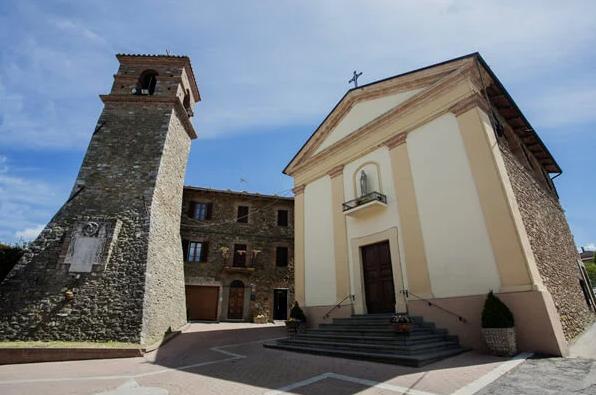Pietrafitta

The town is located at 276 m asl, on the slope of a hill overlooking the vast area of the Tavernelle plain in the municipality of Panicale.The name of the locality seems to derive from the characteristic conformation of the land (soft sandstone) which gave rise to petra ficta , fake stone, not very resistant, then transformed into Pietrafitta.
Abbey of the Seven Brothers
The Abbey of the Sette Fratelli, also called Badia dei Sette Frati rises a short distance from Pietrafitta, between the town and the power station.
The extensive complex was built between the 11th and 12th centuries, an era that marked the strong resumption, throughout the Christian world, of the cult of the first martyrs. It is believed to have been founded by Benedictine monks in memory of the Seven Brothers, sons of Santa Felicita martyred in Rome in 164 AD. The first document that concerns it is a bull of Pope Innocent III, of the year 1136, which places the monastery among the assets of the bishop's table of Perugia. At least from the 14th century an important fair was held at the abbey. In many documents it is also referred to as the Abbey of S. Benedetto di Pietrafitta or Badia dei Sette Fratelli (or Frati). It occupies an area of 1,300 m2 and includes numerous buildings. The portico, the loggias, the cells, the refectory and the imposing entrance remain of the Benedictine monastery. The structure then passed to numerous families from Perugia such as the Oddi, the Baglioni, the Lancellotti, the Archpriests of the Penna and finally the Della Corgna. The grotesque decorations of the loggias, stairs and rooms on the noble floor are due to the latter family in 1570; they represent allegorical scenes and sacred stories (episodes from the Old Testament) and are attributed to Salvio Savini.
The frescoes of the Badia recall the decorations of Palazzo della Corgna in Città della Pieve and Castiglion del Lago: the Pope in 1560 entrusted the entire abbey to the cardinal della Corgna, who transformed the building complex and the church itself. From 1614 the abbey was controlled by the Borghese family of Rome and in 1777 it passed to the Perugino Traiano Vermiglioli family. The structure was confiscated by the state in 1860 and was later bought by private individuals. In addition to the Benedictine monastery, the Romanesque church, with a simple facade enriched by a central rose window that houses the ancient original altar in the apse, closed by a wall in the apse, is part of the complex, which is accessed through a majestic arch by the architect Galeazzo Alessi. Five hundred. The church has a crypt which, although visible, it may still contain important information on the history of the place, all yet to be discovered. The church is in Romanesque style and houses the fresco “Madonna and Child in Glory between Angels and the Seven Brothers”, dated between 1570 - 1580 and probably commissioned by the Della Corgna family to a painter from the circle of Girolamo Danti; probably Scilla Peccenini. In the mural painting, the seven brothers are gathered in adoration of the Virgin and with precise adherence to historical reality, they are represented dressed in the Roman way. Perhaps, given the precise and natural details of the faces, they could represent people who really existed at the time, perhaps precisely the description of the patrons of the work. A small door visible only from the outside, called the door of death, it was used for the exclusive and obligatory transit of coffins. Outside, the Garden of memories has taken shape, in which the same herbs and aromatic plants of the past are grown: each season has its own scent, including rosemary, lavender, rose, vine and wisteria.
Currently the whole complex has been privately owned by the Sposini family since 1921. Two women of the family have renovated and revitalized the precious religious building: not only with the medieval garden, the farmhouse, the period residence and the farm, but also through guided tours by appointment, the rebirth of the fair of the badia, in memory of an ancient farmer's market exhibition and numerous other events including dance, music and theater (Artiturismo).
The church of Santa Maria Assunta
In the center of the town is the Church of Santa Maria Assunta, built in 1866 - 1870 by Lorenzo Valiani. Inside you can admire a wooden crucifix of the seventeenth century, whose characteristic is constituted by the thorns of the head, which do not form the traditional crown, but a cap. This detail takes on an even more important meaning in the light of the archaeological finds that took place in Palestine that testify to some condemned coma, including Jesus Christ, a cap of thorns and not a crown were imposed as a torture as handed down by Christian iconography.
The crucifix belonged to the convent of Cibottola and, when this was suppressed, it was brought at night to Pietrafitta where it is the object of particular veneration.